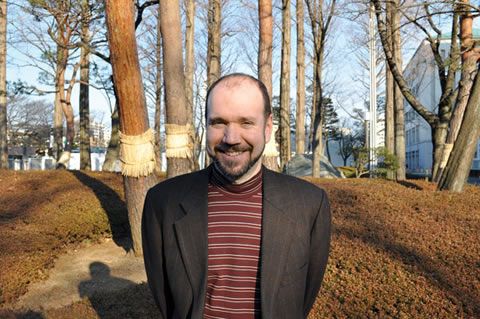On March 11, I was in my ninth-floor office at Dokkyo University just outside of Tokyo. I watched in shock as enormously heavy filing cabinets shook like half-empty matchboxes, and bookshelves emptied all around me. When the tremors subsided to the point where my colleagues and I could walk, we filed ashen-faced down the still-shaking stairwells. We emerged to safety but were shocked once again to hear that we had only received a glancing blow. Further north they had experienced the full force of the Magnitude 9 temblor.
On the day of the quake my only concern was my wife. I began frantically calling, texting and emailing. It would be hours of agony before I could confirm her safety at her office close to our home. (Our house in Hitachinaka City, Ibaraki Prefecture, is 120 kms north of my office – halfway between Tokyo and some of the worst hit areas.)
One year later, my friends and family who live outside of Japan are stunned to hear that aftershocks continue daily. More than 6,000 tremors were recorded in Japan between last March and December – seven times the usual number. Indeed, they are so commonplace that some days we wouldn’t even notice them if it weren’t for the neighbour’s dog reacting to the rattling of their sliding doors. Continual quakes are the new normal where we live.
In fact, the earth remains both unsettled and unsettling. Seismologists tell us these aftershocks are symptomatic of the 70 per cent likelihood of another major quake within the next four years. My wife refuses to drain the bathtub after bathing. If the next aftershock turns out to be the next big one, at least we will be able to flush our toilets this time.
But our fears are not limited to only the possibilities of another earthquake. As it turned out, shutting down the quake- and tsunami-addled Daiichi Nuclear Power Plant would not be an easy task. The past year has seen endless reports of raised radiation levels; then news of the subsequent bans on produce, milk, meat and more.
Sensationalism about these stories – in the Western press, in particular – added insult and worry to injury. Much of the reporting was tinged with political bias when we craved only the truth. One nuclear spokesperson insisted on reminding people of the wonders of modern X-ray technology while radiation of a completely different variety was blowing across the countryside. Just as bad: anti-nuclear bloggers were exploiting our hardship to take shots at the government.
Finally, in December, it was reported that the situation in Fukushima had been “brought under control.” We were also informed that the bill for the cleanup would run to 12 trillion yen (Cdn$160 billion) and that our electricity bills would be raised significantly to help cover it.
The immediate impact of the crisis is readily witnessed in our wallets and in local industry, but our fears today continue to revolve around the unseen and the unpredictable. If my wife or I should take ill many years from now, would we have reason to blame the government? Or would we blame ourselves for spending the past year in the fallout while so many others have fled?
We – along with most of our neighbours – no longer drink tap water for fear of radiation poisoning. The nearest Costco (yes, we have them here, too) clears a Niagara Falls–load of bottled water weekly.
Health concerns are magnified now as my wife and I are expecting the arrival of our first child this summer. I’m told it’s normal for all first-time parents to fear the worst, but if things don’t go according to plan, will we blame ourselves
for not moving?
John P. Racine (BSc 1988 UTSC) is a lecturer in the Interdepartmental English Language Program at Dokkyo University.






No Responses to “ A Year in the Quake Zone ”
This is an interesting and insightful article. I wish there were an easy solution, but I doubt that will be coming anytime soon.
My husband and I are both U of T alumni and we were living in Tokyo when the big quake occurred. It changed our lives profoundly, but we decided to stay despite all of the troubles associated with possible radiation exposure and ongoing aftershocks. I agree with Mr. Racine's stance on how the Western media sensationalized what happened with Fukushima, and the senseless reports on bans of groceries.
However, to say that his family and his neighbours refuse to drink the tap water for fear of radiation exposure, may be causing readers to assume that the tap water is not safe to consume. This is simply not true. The tap water in Tokyo and surrounding areas is safe to drink. We filter it, not because of possible contamination, but because we prefer the taste. To suggest that Japan is under a fallout fog, with the exception of the immediate Fukushima Daiichi area, is just adding to the sensationalism.
I don't discount Mr. Racine's concerns and experiences here in Japan. And his health concerns are important ones, given the impending arrival of his child. However, I do feel it would be responsible to have other perspectives. Japan is a safe and wonderful place to live, we have no intentions of leaving it.
Joanne Yu
PhD 2008
Tokyo